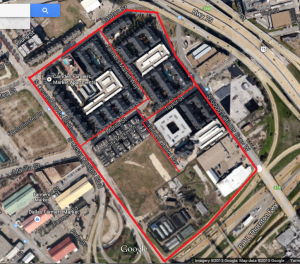In my last post, we talked about the North End apartment complex in Victory Park. With its high black gates, I noted how the complex cut off the flow of traffic and disrupted the city’s street grid. Let’s now turn our attention to a newer development in the southeast corner of downtown – the Camden Farmer’s Market Apartments – but for a completely different reason. While there are no gates impeding traffic, this complex does pose a different problem for the grid, i.e., block sizing. Before we get into the particulars, let’s first start with an overview of the area in question.
As you can see, this development is tied into the grid decently well, with the exception of the lower portion of Farmer Market’s Way, which inexcusably dead-ends. Marilla St., the upper portion of Farmer’s Market Way and Taylor St. all cut through the apartments connecting it to the surrounding grid. Moreover, Taylor St. actually connects to Deep Ellum’s grid, which is good. Sure, the roads aren’t organized very well and come together at a disjointed mess in the middle, but at least people have a way to move through the apartment complex.
The issue here is block length. I know. This sounds like an insignificant point, but the effects on street usability are profound. We’ve already discussed how a robust street grid improves vehicular traffic and reduces congestion by disbursing traffic over many roads instead of only one or two corridors. But an important part of this is block length and size. Short and compact blocks do a better job at disbursing traffic throughout a grid because there are more opportunities to take alternate routes. The need for compact blocks is even more important for pedestrian use. In the words of the oft-quoted Jane Jacobs, “…opportunities to turn corners must be frequent.” Why? Think about your own experiences walking in cities. The streets you enjoyed were probably small and manageable where the buildings hugged the road and there were many opportunities to cut over on other side streets. These types of streets are scaled to the pedestrian level and they’re interesting because the scenery changes often and quickly. The best examples in Dallas can be found in Uptown, State & Thomas or in Lower Greenville. On the other hand, I would venture a guess that your least favorite streets were the long monotonous blocks with no end in sight. These streets make pedestrians feel small and unwanted so people afoot typically steer clear of them. This is the problem with the apartments at the Farmer’s Market. The blocks are far too long.
So how long should blocks be? How big is too big? Not surprisingly, city block sizes vary greatly from city to city and even within different neighborhoods in any given city. If we look at some of the best interconnected and walkable neighborhoods (e.g., Greenwich Village in New York, Nob Hill in San Francisco, or our own Lower McKinney), we find the sweet spot to be about 250 to 450 feet. I would suggest that anything over 500 feet is unfriendly to pedestrian use. The block around Camden (from Canton to Marilla and Cesar Chavez to Farmer’s Market Way) is about 528 feet on each side. And if we look at the portion below Marilla Street, where they are currently building another block of apartments and townhomes, this block length is 1,056 feet. Astonishing. If you compare this to an average block in Uptown (around 350 to 400 feet), it’s quite the difference when on foot. Some of you may also notice that many parts of downtown Dallas violate this small block rule, notably the east-west blocks along Elm, Main and Commerce. Some of these blocks run over 500 feet in length while the north-south connections between these streets are a more manageable 300 to 350 feet. Unfortunately, there are a number of other examples in our downtown (e.g., the mess around the convention center) that show poor block sizing. This is unacceptable for what should be the most compact, pedestrian-friendly part of Dallas.
Some of you may note that smaller blocks will constrain developers and their projects, and I would agree with you. It’s always easier to develop a large tract of land and do with it as you please rather than work around the existing grid. But is this in the city’s long-term interest? Projects come and go. If the city bends over for every big development that comes along and disrupts the grid, what are we left with when those projects aren’t so shiny and new anymore? The city is left with an unreliable street grid. Most developers are only concerned with the life and value of their project or sometimes only until that first recapitalization event when the initial investors can cash out. There are a few exceptions, i.e., developers who are so invested in a neighborhood or street that their long term interests align with the city’s, but not often enough. The city’s focus should be the long-term and how the grid system will be impacted many years down the road.
I don’t think Camden intended such unwieldy block sizes, and the development was probably a victim of its location near the interchange of I-345 and I-30 and the mess that is S. Cesar Chavez Blvd. I do praise them for being one of the first developers willing to go into this part of the city. However, the fact remains that these block sizes are inappropriate for downtown Dallas. The city must be diligent in repairing the grid and sticking to proper block sizing. It’s important, especially in our main city center, which often serves as the public face of Dallas.






